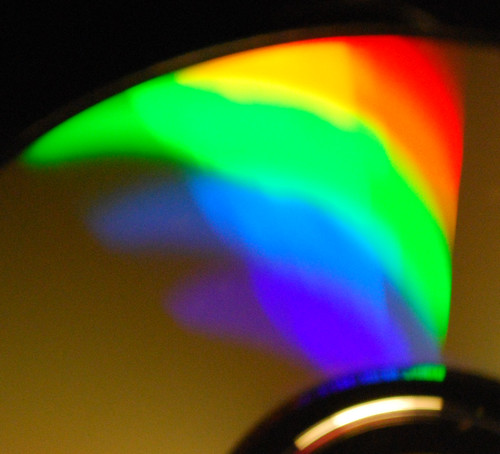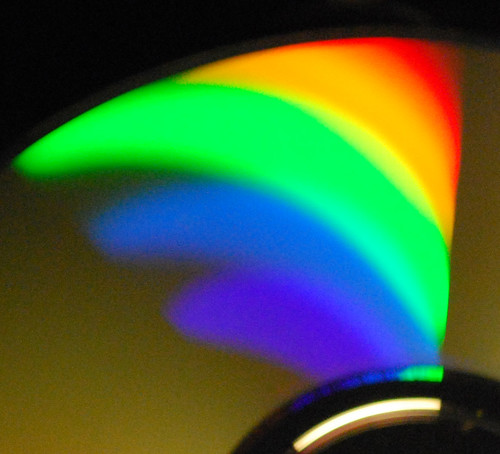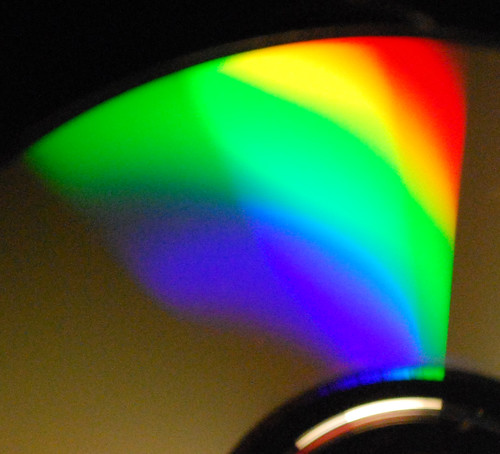 One of the great things about working at Google is the company’s commitment to the environment. This week for Earth Day the company gave each employee two LED light bulbs – much more efficient than regular old incandescent bulbs and better in some ways than the twisty compact fluorescent (CFL) bulbs I already have around the house.
One of the great things about working at Google is the company’s commitment to the environment. This week for Earth Day the company gave each employee two LED light bulbs – much more efficient than regular old incandescent bulbs and better in some ways than the twisty compact fluorescent (CFL) bulbs I already have around the house.
Energy efficiency is one thing, but how do all these different lights compare visually? Three important measures to look at are the color temperature, the color rendering index (CRI), and the light output in lumens. I’ll talk a bit about both and explain a simple science demonstration you can do in your own home.
According to the specs, the Lemnis Lighting Parox II bulbs I got consume 5 Watts (it says 4 on manufacturer’s web site) to produce 200 lumens (website says 230). The color temperature is 2,800K and the CRI is “> 85”, but we’ll get to that later. I have a regular Sylvania bulb, a GE CFL and a Lights of America bulb-style CFL for comparison. Here’s a table with the data on each:
Color Temperature
When you see terms like “soft white” and “daylight”, you’re really hearing about the color temperature. You can read more about it at Wikipedia, but for white lights it effectively it tells you whether the light tends toward yellow on the low end or blue on the high end.
This isn’t a determinant for purchasing one type of bulb or another since you can generally find incandescent, CFLs and LEDs with different color temperatures to suit your needs. Picking the “right” color temperature can be very subjective. All the bulbs I’m comparing are warm, in the 2700-3000 range.
Color Rendering Index (CRI)
CRI is a measure of how well a light supports the full range of colors visible to the human eye, with daylight being 100 at a temperature of about 5000-6000K. You do have to consider temperature too because CRIs are really comparable across the same temperature range. “Soft white” bulbs will make things look more yellow even if they have a high CRI.
Now for the fun science project. The higher the CRI, the more smooth the spectrum should be. Luckily pretty much everyone has a device in their homes that will split light into it’s spectrum across a flat surface – a CD.
Here’s the full, smooth rainbow-light spectrum for an incandescent bulb:
Now, here’s the spectrum for a twist-style CFL:
See the difference? It’s pretty striking. That’s because the CFL generates light white using a small number of colors. The CFL bulb is a little better, but there’s still a lot of gaps (particularly visible in the blues):
Now let’s look at the LED bulb:
It’s actually quite close to the CRI 100 incandescent. These aren’t precise measurements, of course, but my guess is that if GE can get away with a CRI claim of 82 for their CFL than Lemnis could probably say their LED light is a fair bit better than “>85”.
Light output in lumens
The more lumens, the more light. Because we’re interested in efficiency, lumens per Watt is a good number to look at too.
Take a look back at the table again. The LED produces less light than the 40W incandescent (200 lumens to 465) and actually doesn’t do as well as the CFLs in raw lumens per Watt. This is a little misleading, though, since the other bulbs cast light in multiple directions while the LED is more of a hemisphere shape. So in an application where you want light to be somewhat directional, the LED might live up to it’s “40W equivalent” claim. Otherwise it’s going to look dim.
In general, I’m pretty pleased with the LEDs. They’re not as efficient as I had hoped, but they do have advantages over CFLs like better color, much longer life, and lack of mercury. Prices and efficiency are both tending in the right direction for LEDs so I’m sure I’ll be buying them in the future, maybe about the time my CFLs finally give out.




Thanks for the demonstration of CRIs for different bulb types! A great visual reference for the non-techie.
For more help in choosing the best energy efficient bulb for each of your light fixtures, I’ve created The Energy Efficient Light Bulb Buyer’s Guide (see my blog).
Dear sir
We are building a 7 floor building with 15 flats kindly guide me for energy saveing and proper lighting
Loved the CRI examples. I’ve always felt CFL bulbs made me partly blind and I was suspecting missing parts in the spectrum. Thanks!